 Web Content Display
Web Content Display
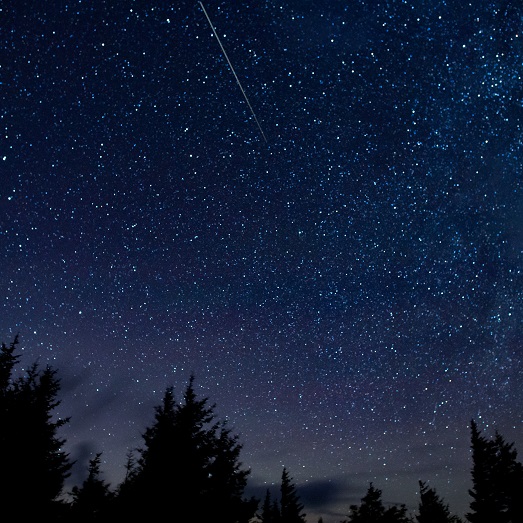
Meteor Shower
Tab Menu
 Web Content Display
Web Content Display
Observation of meteors throws light on our understanding of the motion of the celestial bodies in our Solar System, physical properties of the Earth's upper atmosphere and the spatial distribution of meteoroids (which helps choosing safe and proper trajectories for launch vehicles such as artificial satellites). Fortunately, observation of meteors is relatively easy. Even without the aid of telescopes, amateur astronomers can still collect data with significant scientific value.
Results of observations may be recorded in a standard form and sent to the Hong Kong Astronomical Society. The data will be compiled and processed before being submitted to the International Meteors Organization, Purple Mountain Observatory in Nanjing, China for further analyses.
Address: Hong Kong Astronomical Society, GPO Box 2872, (Attn: Meteor Shower Section)
Put down the name of the observer, the place and time of observation, duration of observation, cloud cover, the sky's limiting magnitude (the magnitude of the faintest star you can see with the naked eye) and the number of meteors observed on the data sheet.
Are you interested in this meaningful observation activity?
 Web Content Display
Web Content Display
First and foremost, this is an activity that any amateur astronomer can manage. Even your relatives or friends without any experience in star gazing can join in, provided you have given them sufficient guidance. The more observers we have, the more data can be collected.
The purpose of this observation is to count the number of visible meteors that belonged to a given meteor shower and those that do not belong to this group. First, identify the constellation where the radiant lies. Watch carefully the path of the meteors. If necessary, you can trace back the path as an imaginary straight line to see whether it intersects with the radiant. If so, the meteor is a shower meteor, otherwise it is a sporadic Record the number of meteors visible per hour, both for the shower meteors and the sporadic meteors.
This is a very simple observation. Plotting the meteors' paths on star maps, which calls for more skills and experience in observing meteors, is generally not required.
To foster more accurate observations of higher scientific value, some equipment is necessary. A reclining lawn chair or a straw mat with a pillow make you feel more comfortable. Remember, comfort is essential for good observations. Do not sit and hold your neck upright as this gesture strains the blood circulation in your neck and thus reduces your eyesight. A faint flashlight or a dim red torch helps you write in the dark. A pencil and a sheet of paper is essential for recording the number of meteors as well as the starting and ending time of observation. Remember to bring a watch along with you. Avoid using roller pens. A roller pen does not write well when you are lying down with the pen pointing upwards.
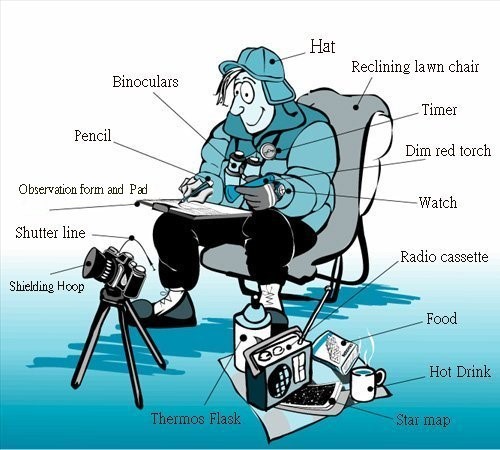
Keep the duration of each observational interval at one hour . You should not observe for more than four hours during any one night, since the accuracy of your data will reduce when fatigue takes hold. To keep you alert and efficient, take a break and consume some food. Warm clothing is necessary to keep your body warm. If you go in pairs or in groups, keep you and your partners apart. Do not exchange your views, since this may introduce unwanted errors into your observation (for instance, the same meteor may be recorded twice as two different meteors). In addition, each person should look at a different part of the sky.
The limiting magnitude must be entered on the data sheet. Below is a table listing the magnitudes of the major stars in the constellation Ursa Minor.
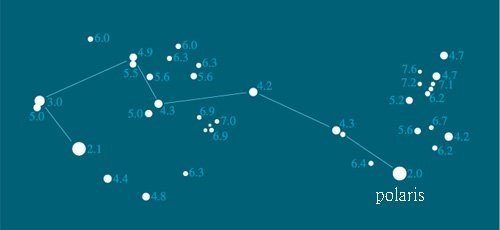
Experienced amateurs can do a lot more. This includes recording the meteors' paths and their lengths, the magnitudes, colours, the presence of trains and their durations, etc. Observers can work in pairs. One carries out the observation with a star-map and a pen and the other records with a record sheet and a piece of watch. When one sees a meteor, he should say ‘yes' and plot the meteor's path on the star-map. He should then tell his partner the magnitude, duration, colour, whether the meteor has exploded or has a persistent train. On hearing 'yes', his partner should put down the time along with all those information that is passed to him. Do not forget to label the meteor's path. Responsibilities of the two should be clear-cut. Personal judgment should be avoided at all costs. While a binocular is helpful to the observation of a meteor train, a cassette recorder can record what has been said about the phenomenon.
A report with qualitative or quantitative conclusions like the following is always welcome: 'The majority of the meteors had exploded', or '40% (+/- 5%) of the meteors are dark red in colour', etc.. A meteor shower becomes a meteor storm when the meteors' hourly rate reaches several hundreds per hour. At this time, you can shorten the time of observation to 5 or 10 minutes, while the region of the sky being monitored can be reduced. These changes should also be specified on the record sheet.
 Web Content Display
Web Content Display
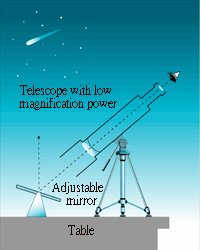
To observe fainter meteors and make your observations run more efficient, a small telescope with a field of view exceeding 7 degrees or a magnifying power not more than 7 should be employed. A binocular mounted on a tripod also serves similar purpose. Put the binocular on a table, pointing it downwards towards a mirror of which the tilting angle can be adjusted. Adjust the angle of the mirror to choose the region of the sky in interest. This method allows the observer to concentrate on a smaller region of the sky and observe fainter meteors with the telescope. What's more, telescopic observations provide a more comfortable posture for the observer. You may also put the record sheet and a dim light on the table.
In completing the record sheet, the aperture, the field of view, the magnifying power of the telescope, together with the co-ordinates of the centre of the observing field (right ascensions and declination) must be filled in.
 Web Content Display
Web Content Display
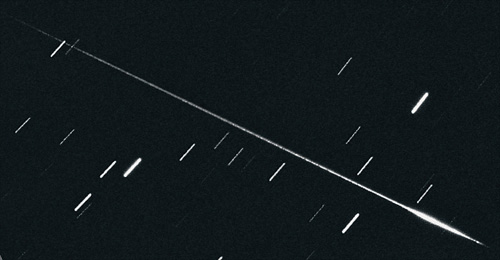
Stationary Photography
Standard lens or wide-angle lens are used. Load the high speed film, open the lens to its lowest f/number and focus at infinity. Select 'B' for the shutter setting. Mount the camera on a tripod and aim it at the desired region. Use the shuttle release to begin the exposure, which can last for several minutes to an hour.
Stationary photography is also known as "star trail photography", since the images of stars will appear as trails because of the Earth's rotation. Long exposure makes the stars trails overlap one another, rendering the identification of constellations more difficult. Detail information of the regions being photographed on each film is beneficial to the compilation of data. Stationary photography should be supplemented with visual observation. By comparing these two sets of data, we can deduce the exact positions where the meteors appear, and the magnitude of the faintest meteors that are captured.
Shooting can stop as soon as a bright meteor appears. Since the endpoints of the meteor trail and the star trails are captured simultaneously, this helps us identify the meteor's exact location and the meteor shower to which it belongs. Photos without proper documentation have low scientific values, since the time of appearance of the meteors is uncertain. On an ordinary night, an average of 1 meteor can be imaged every ten hours, but more should be captured when a meteor shower is active.
Guiding Photography
Guiding Photography using equatorial mount or synchronized motor enables the photographer to capture the same number of meteors as stationary photography does. The advantage of this kind of photography is that it helps the astronomer capture the meteor's motion across the star field. This can reduce a considerable amount of calculation work and minimize subsequent errors. Guiding Photography should be also supplemented by visual observations, so that the time of appearance of the meteors can be confirmed.
